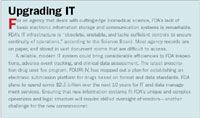FDA Turnaround Time
Pharmaceutical Executive
Will more resourches and new leadership fix FDA, or is a major overhaul in order?
First, there was the international heparin crisis. Then more contaminated food, a crackdown on cough-and-cold medicines for children, melamine in baby formula, and multiple drug safety issues. The Science Board said that FDA cannot do its job due to a depleted work force, obsolete information systems, and a weak science base.

Jill Wechsler
"FDA is barely hanging on by its fingertips," attorney Peter Barton Hutt told Congress a year ago, leading the chorus seeking increased resources for the beleaguered agency.
Since the Vioxx debacle four years ago, FDA's credibility has crumbled, opening the door for Congress and the media to play "kick the FDA," commented professor Alastair Wood in a New England Journal of Medicine editorial last April. A leading critic is Rep. Rosa DeLauro (D-CT), who chairs the House Appropriations subcommittee that oversees FDA's budget. At an Institute of Medicine meeting in April, DeLauro asserted that FDA needs "urgent and dramatic reform" because it cannot perform basic functions, such as tracking clinical trials, conducting required inspections, and following up on postmarket study commitments.
DeLauro blames many of FDA's ills on Big Pharma, and has blocked funding for the Reagan-Udall Foundation until its organizers ensure that it's "not just another tool for industry."
She even fears that FDA's Critical Path Initiative may send the message to agency scientists that it's more important to develop methods to support product approvals than to objectively evaluate safety and efficacy data. DeLauro would like a three-year moratorium on direct-to-consumer advertising of newly approved drugs and stiffer curbs on conflicts-of-interest for members of advisory committees.

Upgrading IT
Watershed Time
A new administration and new FDA leadership could provide an opportunity for change. This is a watershed moment for FDA and the pharmaceutical industry, according to Janet Woodcock, director of the Center for Drug Evaluation and Research (CDER). The public is concerned about drug quality and imports, industry is struggling with a productivity crisis, and the global financial meltdown may dry up investment for biomedical innovation, she observed at a fall meeting sponsored by the Generic Pharmaceutical Association. Woodcock's aim is to restore public confidence in the drug regulatory process, capitalize on advances in science and technology, improve postmarket oversight, and make FDA "the recognized leader in drug regulation."
Efforts to achieve those goals will be shaped by FDA's next commissioner. Many names have been circulated for the position in the last month—a sign of the agency's high visibility and importance to the new administration and to Congress. There's considerable hope that FDA's new leader will be named and confirmed by the Senate in a few months, instead of languishing at the bottom of the White House appointments list.
FDA's leader needs management and leadership skills, and familiarity with FDA's mission is helpful, says former commissioner Mark McClellan, now at the Brookings Institution. "This is a complex agency," he notes, "And it can't be run by command-and-control, but by providing support for staff to do outstanding science-based work."
One priority for the new commissioner will be to justify continued growth in appropriated funds for the agency's 2010 budget. The Alliance for a Stronger FDA has called for a 20 percent increase in FDA appropriations, to $2.25 billion for next year. That's less than $400 million in new money —a drop in the bucket for most federal agencies.
FDA and industry also hope that with Democrats in control of both the White House and Congress, there will be fewer attacks on the agency from Capitol Hill. An effective commissioner can provide "a heat shield from criticism for the agency," says McClellan, adding that it's easier to get financial support when there's clarity about the direction FDA will take.
Fixing the Field
Another priority for a new commissioner is to revive FDA's depleted field force. The Office of Regulatory Affairs (ORA), which inspects food and drug manufacturing facilities, is in disarray due to years of neglect and under-funding. FDA's 70-year-old inspection model relies on generalists to cover a wide range of operations, an approach that doesn't fit the high-tech world of biomedical production. Many ORA officials have retired or moved to other jobs, leaving the organization without the leadership needed to deal with globalization, technical advances, and inadequate IT. Heparin was "a wake-up call," says Woodcock, that "brought home the need for vigilance throughout the supply chain."
One response is FDA's Beyond our Borders initiative, which is establishing overseas branches to better monitor foreign manufacturers of products destined for the US. The agency opened offices in China in November, and has plans for additional outposts in India, Europe, Latin America, and the Middle East to track local developments and be on the spot if problems arise.
But even with more resources and foreign offices, FDA will never be able to inspect every manufacturer on a timely basis. Field operations require innovative approaches, such as certification programs for foreign manufacturers, increased reliance on inspections by foreign regulatory authorities, improved risk management of inspection programs, and high-tech field laboratories.
The "F" in FDA
A major challenge for FDA's field force is to oversee about 80 percent of the US food supply, much of it now imported. Because food is regulated very differently from medical products, DeLauro and others propose to shift foods away from FDA to a new federal agency that would assume responsibility for multiple food-related programs now spread around a dozen government offices.
The Department of Health and Human Services has opposed such a move, claiming that food safety is more a public health issue than the province of agricultural interests. To back up the status quo, last month FDA issued a one-year progress report on its Food Protection Plan, describing the many initiatives underway for preventing and handling food contamination problems.
FDA leaders also propose a less radical change that involves splitting FDA into two "directorates," one for food and one for medical products. There is support for such a move from food operators, who feel they play second fiddle to drugs at FDA, and also from medical product companies that fear being hit by more restrictive food import policies.
The political reality is that a major change like taking the "food" out of FDA is not likely to happen any time soon. The Obama administration has more crucial tasks at hand in the economic and health arenas, and most members of Congress are unenthusiastic about altering committee oversight responsibilities. Former FDA official Wayne Pines notes that reorganizations end up "just moving boxes around and not increasing efficiency." But if Congress follows through on proposals to authorize FDA to regulate tobacco, that could provide an opportunity for broader changes in agency structure and operations.
The bottom line for pharma is for FDA to have the resources to approve new drugs for market and to oversee product development, manufacturing, and marketing in a fair and efficient manner. All the focus on drug safety has raised fears about a more risk-averse attitude and a slowdown in application reviews. But industry recognizes that FDA has been busy tackling new authorities and training new employees, says Alan Goldhammer of the Pharmaceutical Research and Manufacturers of America (PhRMA). "It really is this upcoming year that will be critical in looking at performance and benchmarking against PDUFA [Prescription Drug User Fee Act] goals."
A bright light on the horizon is an increase in new drugs coming to market. The agency hit a low for approvals in 2007, and it looked like 2008 would be just as bad or worse. FDA reviewers were missing review deadlines, demanding additional data, and imposing stiff postmarket monitoring requirements on those products that made it through the process. But in November, FDA surpassed the 2007 approval total of 18 new molecular entities, and by year-end was slated to approve 21 new drugs for the year. While it's always easier to show gains from a very low starting point, both industry and FDA are happy to consider this a sign of hope for the new year.
Jill Wechsler is Pharmaceutical Executive's Washington correspondent. She can be reached at jwechsler@advanstar.com
Addressing Disparities in Psoriasis Trials: Takeda's Strategies for Inclusivity in Clinical Research
April 14th 2025LaShell Robinson, Head of Global Feasibility and Trial Equity at Takeda, speaks about the company's strategies to engage patients in underrepresented populations in its phase III psoriasis trials.
Beyond the Prescription: Pharma's Role in Digital Health Conversations
April 1st 2025Join us for an insightful conversation with Jennifer Harakal, Head of Regulatory Affairs at Canopy Life Sciences, as we unpack the evolving intersection of social media and healthcare decisions. Discover how pharmaceutical companies can navigate regulatory challenges while meaningfully engaging with consumers in digital spaces. Jennifer shares expert strategies for responsible marketing, working with influencers, and creating educational content that bridges the gap between patients and healthcare providers. A must-listen for pharma marketers looking to build trust and compliance in today's social media landscape.
